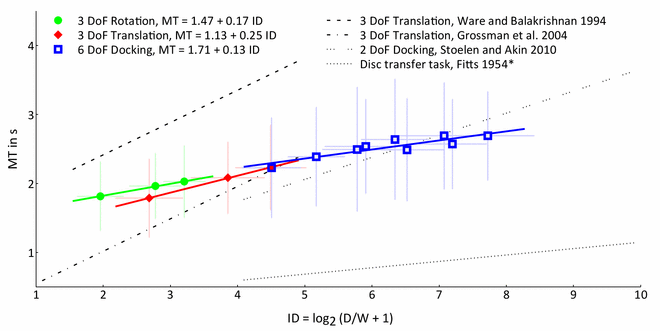Linear regression with Fitts’s model of motor performance in three different aimed movement tasks: 3D Rotation, 3D Translation, and 3D Docking with six degrees of freedom. Indices of difficulty were derived from effective target widths and distances, hence, varying for each user and subtask (error bars show standard deviations on both axes). For comparison, we also plotted the linear regressions from prior studies [12,20,57,69] in the range of the respectively tested IDs.
* Fitts’s original data from the disc transfer task recomputed by MacKenzie [39] using the Shannon formulation
Abstract
Fitts’s law facilitates approximate comparisons of target acquisition performance across a variety of settings. Conceptually, also the index of difficulty of 3D object manipulation with six degrees of freedom can be computed, which allows the comparison of results from different studies. Prior experiments, however, often revealed much worse performance than one would reasonably expect on this basis. We argue that this discrepancy stems from confounding variables and show how Fitts’s law and related research methods can be applied to isolate and identify relevant factors of motor performance in 3D manipulation tasks. The results of a formal user study (n=21) demonstrate competitive performance in compliance with Fitts’s model and provide empirical evidence that simultaneous 3D rotation and translation can be beneficial.
Publication
A. Kulik, A. Kunert and B. Froehlich, "On Motor Performance in Virtual 3D Object Manipulation," in IEEE Transactions on Visualization and Computer Graphics, vol. 26, no. 5, pp. 2041-2050, May 2020.
DOI: 10.1109/TVCG.2020.2973034
[IEEE][preprint]

